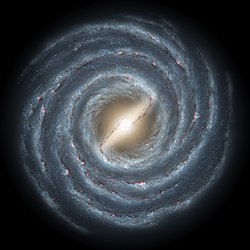Pisces-I-Zwerggalaxie
| Galaxie Pisces-I-Zwerggalaxie | |
|---|---|
| AladinLite | |
| Sternbild | Fische |
| Position Äquinoktium: J2000.0, Epoche: J2000.0 | |
| Rektaszension | 01h 03m 56,6s[1] |
| Deklination | 21° 53′ 41″ [1] |
| Erscheinungsbild | |
| Morphologischer Typ | dSph/dIrr |
| Winkelausdehnung | 1° [2] |
| Physikalische Daten | |
| Zugehörigkeit | Lokale Gruppe |
| Radialgeschwindigkeit | −75 km/s [2] |
| Entfernung | 260.000 Lj / 80.000 pc [3] |
| Geschichte | |
| Entdeckungsdatum | 2009 |
| Katalogbezeichnungen | |
| PGC 3792 • Pisces I[4][5] | |
Die Pisces-I-Zwerggalaxie (kurz auch Pisces I) ist eine Zwerggalaxie im Sternbild Fische (lat. Pisces), die sich im Zerfall befindet. Sie ist noch als Überhäufigkeit im galaktischen Halo zu erkennen.[4] Sie wurde im Jahr 2009 nach Analyse der Verteilung der RR-Lyrae-Sterne in der Durchmusterung des Sloan Digital Sky Survey entdeckt.[3]
Pices I ist einer der lichtschwächsten Trabanten unserer Milchstraße.[4] Ihre Masse lässt sich nur schwer abschätzen, da sie nicht mit der Geschwindigkeitsdispersion korreliert. Es wird ein Wert von etwa 105 M☉ genannt.[3]
Die Galaxie befindet sich in einer Entfernung von 80 kpc zu unserem Sonnensystem und bewegt sich mit einer Geschwindigkeit von 75 km/s darauf zu.[2]
Die große Ausdehnung von etwa 1° einerseits und die irreguläre Form anderseits zeigen, dass sich Pisces I im Übergang befindet von einem gravitativ gebundenen zu einem gravitativ ungebundenen System.[2]
Pisces I befindet sich nahe der Ebene der Magellanschen Wolken. Möglicherweise existiert eine physische Verbindung zwischen Pisces I und dem Magellanschen Strom[3].
Einzelnachweise
- ↑ Igor D. Karachentsev, Valentina E. Karachentseva, Walter K. Huchtmeier, Dmitry I. Makarov: A Catalog of Neighboring Galaxies. In: The Astronomical Journal. 127, Nr. 4, April 2004, S. 2031–2068. bibcode:2004AJ....127.2031K. doi:10.1086/382905.
- ↑ a b c d Juna A. Kollmeier, Andrew Gould, Stephen Shectman, Ian B. Thompson, George W. Preston, Joshua D. Simon, Jeffrey D. Crane, Željko Ivezić u. a.: Spectroscopic Confirmation of the Pisces Overdensity. In: The Astrophysical Journal Letters. 705, Nr. 2, 2009, S. L158–L162. arxiv:0908.1381. bibcode:2009ApJ...705L.158K. doi:10.1088/0004-637X/705/2/L158.
- ↑ a b c d L. L. Watkins, N. W. Evans, V. Belokurov, M. C. Smith, P. C. Hewett, D. M. Bramich, G. F. Gilmore, M. J. Irwin u. a.: Substructure revealed by RR Lyraes in SDSS Stripe 82. In: Monthly Notices of the Royal Astronomical Society. 398, Nr. 4, 2009, S. 1757–70. arxiv:0906.0498. bibcode:2009MNRAS.398.1757W. doi:10.1111/j.1365-2966.2009.15242.x.
- ↑ a b c V. Belokurov, M. G. Walker, N. W. Evans, G. Gilmore, M. J. Irwin, D. Just, S. Koposov, M. Mateo u. a.: Big fish, small fish: Two New Ultra-Faint Satellites of the Milky Way. In: The Astrophysical Journal Letters. 712, 2010, S. L103–106. arxiv:1002.0504. bibcode:2010ApJ...712L.103B. doi:10.1088/2041-8205/712/1/L103.
- ↑ SIMBAD Astronomical Database. In: Results for Pisces I. Abgerufen am 13. Februar 2010.
Auf dieser Seite verwendete Medien
Caption from NASA: Like early explorers mapping the continents of our globe, astronomers are busy charting the spiral structure of our galaxy, the Milky Way. Using infrared images from NASA's Spitzer Space Telescope, scientists have discovered that the Milky Way's elegant spiral structure is dominated by just two arms wrapping off the ends of a central bar of stars. Previously, our galaxy was thought to possess four major arms.
This artist's concept illustrates the new view of the Milky Way, along with other findings presented at the 212th American Astronomical Society meeting in St. Louis, Mo. The galaxy's two major arms (Scutum-Centaurus and Perseus) can be seen attached to the ends of a thick central bar, while the two now-demoted minor arms (Norma and Sagittarius) are less distinct and located between the major arms. The major arms consist of the highest densities of both young and old stars; the minor arms are primarily filled with gas and pockets of star-forming activity.
The artist's concept also includes a new spiral arm, called the "Far-3 kiloparsec arm," discovered via a radio-telescope survey of gas in the Milky Way. This arm is shorter than the two major arms and lies along the bar of the galaxy.
Our sun lies near a small, partial arm called the Orion Arm, or Orion Spur, located between the Sagittarius and Perseus arms.



